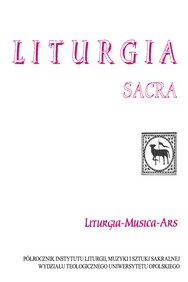„Kościół tak niezwykle zły, że zdaje się być oborą”, czyli jak przekonać luteranów do wizyty w brzydkim kościele. Problem wyglądu i lokalizacji świątyni w kazaniu konsekracyjnym pielgrzymkowego kościoła granicznego w Cigacicach (1655, wyd. 1665)
„A church so bad it seems to be a barn”, or how to convince Lutherans to visit an ugly church. The problem of a church’s look and location in the consecration sermon of the pilgrimage border church in Cigacice (1655, published 1665)
Author(s): Wojciech GrukSubject(s): Christian Theology and Religion, Architecture, History of Church(es), Aesthetics, 17th Century
Published by: Uniwersytet Opolski
Keywords: Protestant Art; History of Silesia; Pilgrimages; Church Architecture Aesthetics; Persecuted Minorities; Identity Studies;
Summary/Abstract: The article discusses the inconvenient location and the ugliness of the church as factors potentially discouraging the faithful from visiting it, as well as attempts to overcome them discursively. The article is based on a sermon by pastor Zacharias Textor published in 1665 on the occasion of the consecration of the newly built pilgrimage church located in the secluded Cigacice Forest, in the Margraviate of Brandenburg, near the Silesian border. According to the preacher, the building was so modest that for pilgrims - Lutherans from the neighboring Duchy of Głogów, where their worship was forbidden - it resembled a barn rather than a church. The article provides a reconstruction of Textor’s sermon, aimed at a positive reinterpretation of the negative features of the temple, based on the story of the biblical Jacob (Genesis 28). The analysis of Textor’s argument allows us to better understand the significance of the church building and its equipment in the specific pilgrimage culture of Silesian Lutherans, which developed after the Thirty Years’ War, providing the basis for a more complete interpretation of the related works of architecture and art. The article is enriched with numerous quotations from the sermon, including extensive fragments of a unique description of a temporary temple that has not existed for centuries.
Journal: Liturgia Sacra
- Issue Year: XXVII/2021
- Issue No: 58
- Page Range: 181-199
- Page Count: 19
- Language: Polish

